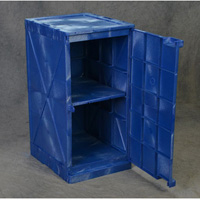 |
 |
| MSDS Topics |
Free Sites | FAQ's | Regulations | Glossary | Software | Suppliers |
| Books | Forum | Poll | Fun stuff | Quiz | Store | |
| MSDS and safety supplies | Search ALL our MSDS info | |||||
 | |||
 |
 |
 |
|
| Title: 09/04/1985 - MSDS and label requirements for an antiknock compound containing EDB, EDC, and tetraethyl lead. | |
| Record Type: Interpretation | Standard Number: 1910.1200 |
|
September 4, 1985
Mr. Thomas S. Allen Dear Tom: Thank you for your letter of June 13, 1985, regarding questions you have concerning interpretations of the Hazard Communication Standard. The responses are as follows. |  These handy MSDS binder training inserts and other OSHA compliance materials are available at Safety Emporium. |
On the label, the standard required "appropriate hazard warnings." There is obviously a need for professional judgment to determine what is "appropriate" in each situation. However, in areas where a judgment must be made, it would be prudent to err on the side of disclosure. This approach is consistent with the intent of the standard. Given the high percentage of both EDB and EDC present in your compound, my personal opinion is that the chronic hazards should certainly be on the label as well as on the MSDS.
With regard to question no. 2, I think it would be reasonable to assume that if a component that is corrosive by itself is not shown to be so when tested in a mixture where it comprises 25% of the compound, it would also not render the mixture corrosive when it comprises 1-5%. Of course, that assumption is also based upon the diluent being the same, and not something which could produce a synergistic effect. When you state that the label would only cover the acute hazards of the mixture, I assume that you mean there are no chronic hazards associated with the mixture. I am also assuming that corrosivity is the only health hazard ZDDP contributes to the mixture.
|
The answer to question no. 3 is related to no. 1. Again, the MSDS is a compilation of everything known about a chemical, whereas some degree of judgment is required to determine what is "appropriate" to put on a label. Certainly, the IARC information must be on the MSDS. And unless there is a scientifically defensible reason not to, I would indicate the cancer hazard on the label as well. I hope this information is helpful to you. If we can be of further assistance to you, please do not hesitate to contact us. Sincerely,
Jennifer C. Silk |  Safety Emporium has all kinds of labels for assisting with your OSHA compliance needs. |
JUNE 13, 1985
Miss Jennifer Silk
U.S. Department of Labor - OSHA
Room N3663
200 Constitution Avenue, N.W.
Washington, DC 20210
Dear Jennifer:
I very much appreciate your willingness to answer in writing several questions that were causing us concern in the MSDS and label areas.
For our antiknock compound with the composition
Tetraethyl lead 61.45% EDB 17.85% EDC 18.80% Inerts & Dye 1.90%
We currently classify the product as highly toxic by ingestion, absorption, and inhalation.
In developing new labels and MSDS to comply with current OSHA Hazard Communication Rule we wonder if we should show on the MSDS and/or label the chronic hazards associated with the EDB and EDC?
In our judgment the PEL of TEL at 75 ug/m3 coupled with the industrial hygiene required to avoid toxicity from TEL will result in no meaningful risk from either EDB or EDC. In addition to respiratory protection where overexposure might occur, protective clothing, foot protection, goggles and impermeable gloves are required.
Because of the wide PEL difference between TEL at 0.075 mg Pb/m3 we are concerned that emphasizing the chronic hazard from EDB will detract from the emphasis needed to protect from the organic lead hazard.
|
Question No. 2 For some our lube oil additives containing ZDDP (Zinc Dialkyldithiophosphate) we would like to know if our toxicologist can use judgment for those mixtures containing substantially less ZDDP than a tested mixture? Specifically, we have found that oil mixtures containing less than 25 wt % of ZDDP are not corrosive. We feel that mixtures containing 5% or 1% could be considered not corrosive on a judgment without test. In these cases the MSDS would list the ZDDP as being present but it would not state that the ZDDP was itself corrosive or that the mixture was corrosive. The label would of course cover only the acute hazards of the mixture. |  Get your corrosion-resistant polyethylene acid storage cabinets from Safety Emporium. |
Many of our products contain from 1 to 15% of an aromatic oil listed in IARC as an animal carcinogen. The exact amount is confidential. We would of course show this aromatic oil as present. We would, however, use the judgment of the toxicologist in determining when to list the chronic hazard on the label. We would do this depending on the amount of diluent oil we judge to be a cancer hazard. Is this policy in accord with the interest of the OSHA rule?
As I explained to you on the phone, all of us within Ethyl Corporation are enthusiastic in complying with all facets of the OSHA rule. It was in fact this enthusiasm that caused honest differences of opinion within the group and lead to this inquire. These few answers will greatly aid us in fulfilling our corporate obligations in this area.
We very much appreciate your helping us on this matter.
Sincerely,
Thomas S. Allen
Product Label Specialist
ETHYL CORPORATION Technical Center
Toxicology and Industrial Hygiene Department
P.O. Box 14799
Baton Rouge, Louisiana 70898
Telephone (504)389-7600
The official, public domain, OSHA version of this document is available at http://www.osha.gov/pls/oshaweb/owadisp.show_document?p_table=INTERPRETATIONS&p_id=19323&p_text_version=FALSE